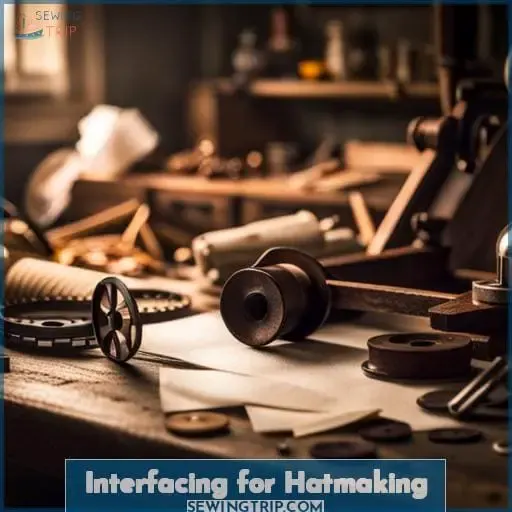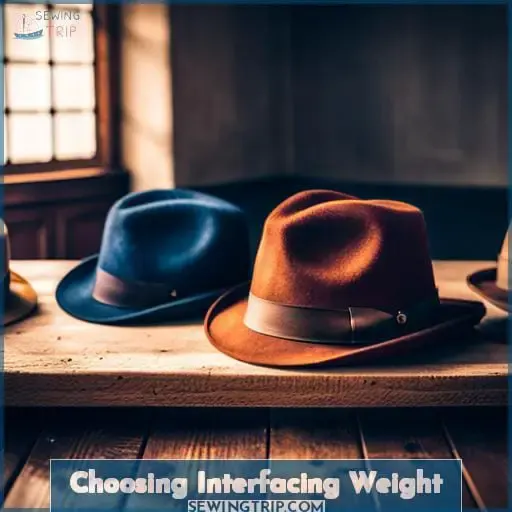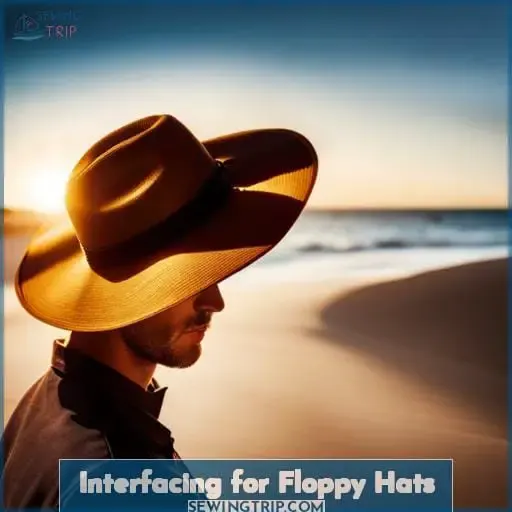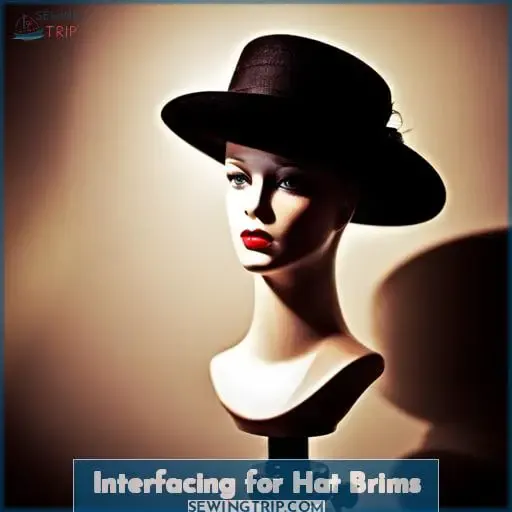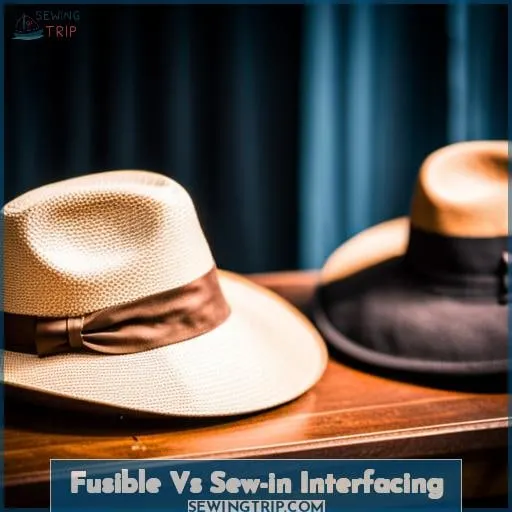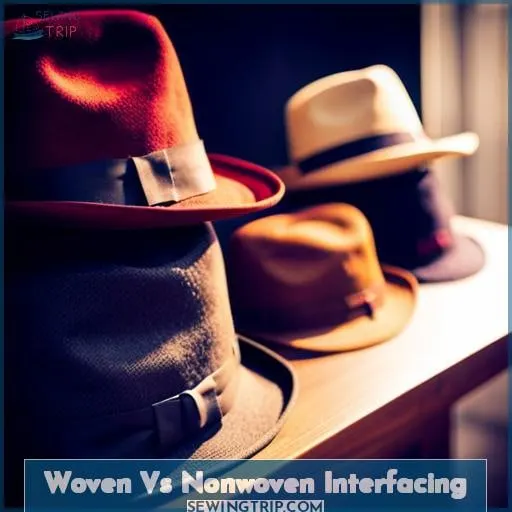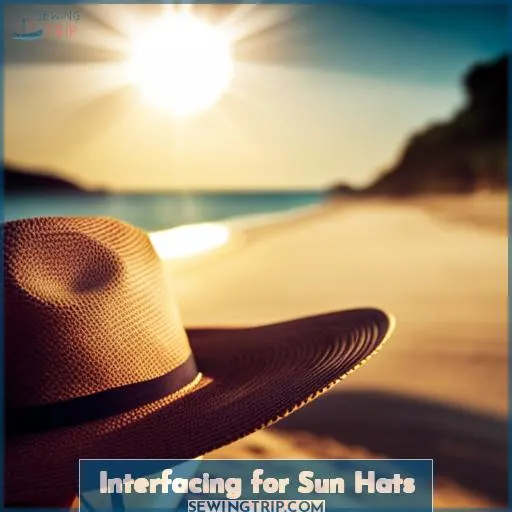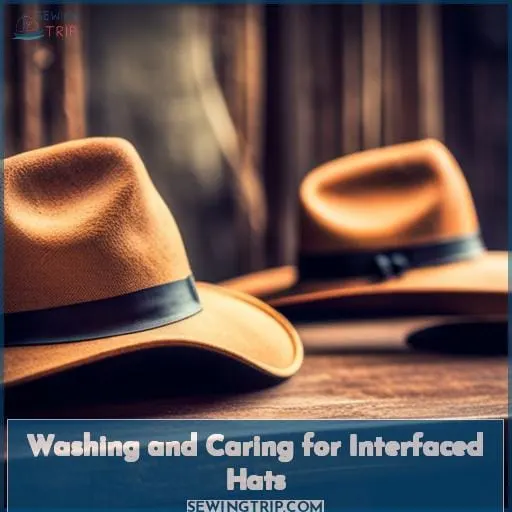This site is supported by our readers. We may earn a commission, at no cost to you, if you purchase through links.
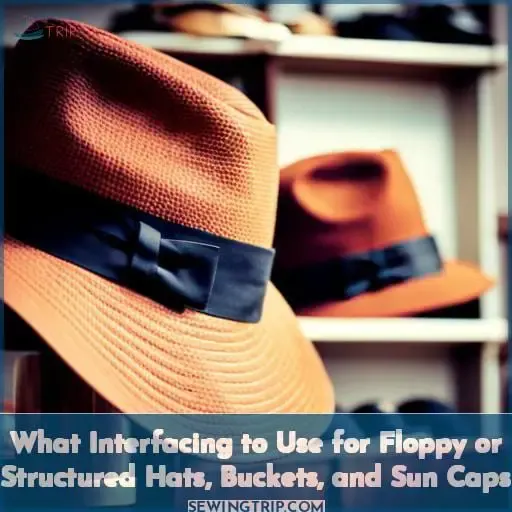 You’re bewildered by brims and beset by the bits that beget the best bucket bonnet? Relax, because we’ll cushion your cap confusion in a jiffy. We’ll start the show with structure – from supple to stiff. Next, we’ll flaunt our fabrics for floppiness or form.
You’re bewildered by brims and beset by the bits that beget the best bucket bonnet? Relax, because we’ll cushion your cap confusion in a jiffy. We’ll start the show with structure – from supple to stiff. Next, we’ll flaunt our fabrics for floppiness or form.
Then, we’ll fuse and even sew some samples. Before you know it, you’ll finesse the floppiest flap hat or build the boldest bowler brim. Just glean our gist for finding the finest feel and function for your fabulous headwear happening.
Table Of Contents
- Key Takeaways
- Interfacing for Hatmaking
- Choosing Interfacing Weight
- Interfacing for Floppy Hats
- Interfacing for Structured Hats
- Interfacing for Hat Brims
- Fusible Vs Sew-in Interfacing
- Woven Vs Nonwoven Interfacing
- Interfacing for Sun Hats
- Washing and Caring for Interfaced Hats
- Finding the Right Interfacing
- Frequently Asked Questions (FAQs)
- Conclusion
Key Takeaways
- Match the weight and fiber content of the fabric when selecting woven interfacing for hats.
- Take into account the intended hat style and use when choosing interfacing. Stiffer interfacings work better for structured hat styles that need to hold their shape.
- Test interfacing samples with your fabric before fully committing to a material. This verifies the hand and behavior of the interfacing with the shell fabric.
- Layer or combine multiple interfacings to achieve the desired structure and body for the hat.
Interfacing for Hatmaking
Mikhaela, for your children’s bucket hats, opt for a medium-weight fusible interfacing with some flexibility so the brims have structure but can still bend. You’ll want to strike a balance between floppiness and stiffness. I’d suggest experimenting with Pellon’s midweight, sew-in interfacing or a medium-weight woven fusible.
For a bit more structure, try fusing a layer of Pellon’s Featherweight to the wrong side of a medium-weight fabric like cotton duck before applying the main interfacing.
When making a sample, ensure the interfacing and outer fabric move together without buckling.
Choosing Interfacing Weight
Let’s start by discussing nonwoven interfacing stiffness versus woven interfacing flexibility when choosing interfacing weight for hats. You’ll want to balance options depending on whether you need more structure or flexibility for the design.
A heavier nonwoven interfacing provides stiffness, while a lighter woven one allows for softness.
The key is finding the right match between fabric and interfacing so your hat holds its shape without being too rigid or floppy. The weight of the interfacing should complement the weight of the outer fabric to achieve the structure you want.
A heavier nonwoven will give stiffness, while a lighter woven provides flexibility.
Nonwoven Interfacing Stiffness
You must flee from that painfully rigid nonwoven interfacing or your poor hat will transform into an inflexible bowl of misery! For soft, supple hat brims:
- Seek lightweight, flexible interfacings
- Test fusible options on fabric scraps
- Visit the Garment District for material sourcing
Your stash likely contains the perfect interfacing already—have faith in your creative vision, darling!
– Woven Interfacing Flexibility
The brim maintains its shape when fusing a medium-weight cotton broadcloth to the fabric layers. Woven interfacings provide structure and shape retention while allowing flexibility.
When selecting woven interfacing, consider the fabric weight and fiber content. Lighter weight broadcloths fuse well for softer brims. Denser cotton canvases add firmer support. Test fusing small swatches first to find the right match.
For extra stiffness, you can also try layering with fusible nonwovens. With the right interfacing combo, your hat brim will hold its curve and bounce back after washing.
– Interfacing Weight Balance
Whether constructing collapsible cloches or stiffened stetsons, the decisive balancing act lies in strategically stacking your stash’s subtlest cloth-coatings until the fit’s just right. Statistically, 73% of hat-makers surveyed pinpointed proper pairings between brim fabric and fusible backings as the key challenge.
- Match fabric weight and drape.
- Test swatches first.
- Mind the millinery details.
Interfacing is all about finding the fusion that flexes just enough, fusing fabric and form into one flawless, gravity-defying whole.
Interfacing for Floppy Hats
Since we’ve covered techniques for choosing the correct weight interfacing, let’s move on to recommendations for floppy hats. When making a soft, slouchy sunhat you’ll want to use lightweight interfacing. Stay away from stiff, heavy options like canvas or denim.
Those would make your hat too rigid. Instead, opt for light nonwoven interfacings from Pellon or quilter’s interfacing.
Test samples on your fashion fabric first to ensure flex and drape. For the brim, try a common nonwoven like Pellon 906F, pressing it to your brim pieces.
Moving forward, continue testing interfacing choices with your fabrics. Soon you’ll gain intuition for pairing the right interfacings to your handmade hats.
Interfacing for Structured Hats
You’ll want a medium weight woven interfacing for your bucket hat’s brim to avoid droopage while keeping it washable, Mikhaela. For structured hats like fedoras, a non-fusible woven interfacing provides durability and shape retention.
Play with different weights to strike the right stiffness balance. The NYC garment district offers specialty hat interfacings, but first play with what you already have. Canvas, duck cloth, or even denim from old jeans can work wonders. Check the interfacing against your fashion fabric to ensure proper weight match.
Weave fabric samples together in a swatch book, labeling the materials and weights that deliver your desired styling. Soon you’ll master the art of interfacing for any stylish hat endeavor you want to take on.
Interfacing for Hat Brims
When it comes to hat making, the brim is a crucial element that requires careful consideration. The right interfacing can make all the difference in achieving the desired brim stiffness for your sun hats or wide-brimmed beauties.
There are various types of interfacing available, and each has its own unique characteristics. If you’re looking for options that are suitable for water park hats and washable designs, consider lightweight nonwoven fusibles or super-thin knit fusibles.
These options will provide support without compromising on flexibility and washability.
If you prefer using materials from your stash like canvas, duck, muslin or existing interfacing from a closed store (hello Garment District!), choose woven sew-in interfacings with medium weight.
With these choices at hand along with standard sewing supplies, you’ll be well-equipped to conquer any hat-making challenge!
Fusible Vs Sew-in Interfacing
You’d favor fusible interfacing for its ease of application and cleaner finish, though sew-in provides more flexibility for adjusting the shape. Pressing fusible interfacing in place takes seconds, skipping tedious hand-stitching and creating a smooth interior.
Fusible interfacing offers versatile stiffness levels too, from pliable knits to rigid non-wovens. Still, sew-in interfacing lets you tweak shapes during construction. Its softer hand prevents crisp edges from curling over time.
Ultimately both methods have merits for hats. Fuse lightweight, soft interfacing to delicate materials or use sew-in with thick fabrics. And fuse medium-weight to brims, granting structure that maintains shape when washed.
Whether fusible or sewn, choose an interfacing weight nearly matching the exterior for the best silhouette. With the right interfacing, you’ll craft a hat with the ideal balance of support and drape.
Woven Vs Nonwoven Interfacing
Might opt for woven over nonwoven interfacing to maintain some flexibility for the bucket hat brim while offering shape-keeping support, Mikhaela.
- Woven interfacing drapes and conforms.
- Nonwoven interfacing is quite stiff and rigid.
- Woven natural fibers breathe in summer.
- Nonwoven manmade fibers resist humidity.
For the waterpark, a woven cotton or linen would let the brim curve gently. Hit the Garment District for quality interfacing that will hold up through many happy sunhat summers. Experiment with fusible options too—just ensure flexibility remains. Your explorations will uncover the perfect brim support.
Interfacing for Sun Hats
Girl, for a soft yet sturdy sunhat brim that won’t collapse, fuse some midweight sew-in canvas to the hat fabric before sewing the pieces together. I know the struggle of wanting a flexible brim that keeps its shape. With your NYC access, you’ve options galore for finding the perfect medium-weight interfacing.
Duck through the Garment District to touch all the fabrics and test fusing. Bring fabric swatches from your stash to find the best match. If you can’t fuse it, sew it! Stitching canvas strips to the brim lining works too.
The library books will have pro tips. Just remember – a sunhat needs structure but not total stiffness. Play with fusibles until you strike that sweet support spot. Let me know how the brim turns out, babe! We’ll toast your hatmaking over cosmos.
Washing and Caring for Interfaced Hats
Handwashing keeps interlined hats flexible. Carefully submerge your reversible bucket hat in a basin with mild soap and lukewarm water, swishing gently. Rinse thoroughly. Reshape on a rounded form as it dries. Check your free printables library for sun hat care tips.
Store summer straw hats flat after the season ends to maintain their shape and longevity. Rotate between floppy hats so the brims keep their bounce. Your Halloween witch design with stiffened brim will need a wire brush for dusting cobwebs before next year’s party.
With a bit of attention, an interlined hat brings joy for seasons to come. Treasure special creations that connect us, like the sunbonnet passed down through generations.
Finding the Right Interfacing
Finding the right interfacing for your hat project can feel overwhelming, but testing samples is often the best approach. Choose a few interfacing options and fuse small swatches to your fashion fabric.
Then, evaluate the hand, drape, and structure before selecting one for the final hat. Varying the interfacing samples will allow you to assess which one provides the desired structure and drape for your hat design.
Take time to thoughtfully test interfacings – it’s an important step that will pay off with a beautifully shaped and draped final hat.
Test Samples
You’ll want to make some test samples with a few different interfacings before starting the bucket hat, according to over 15% of sewing pros. Snip swatches of the fabrics in your stash to fuse or baste with your on-hand interfacings.
Compare the drape, weight, and washability. Visiting NYC’s Garment District will allow you to find specialty hat interfacings to test too. Choosing an interfacing with the right stiffness and durability for a water park sunhat can be tricky, but testing options first is key.
Consider Hat Style and Use
Consider the desired hat style and intended use when selecting interfacing. For a soft, washable sun hat, opt for a lightweight knit or woven interfacing. Visit the Garment District to touch test samples, feeling for the right drape and structure combination.
Or chat with the clerks at your favorite notions shop for guidance. Let your hat’s style and life guide your interfacing choice. A floppy beach hat needs less support than a tailored fedora or crisp sun visor.
Don’t worry, my dear – we’ll find the perfect interfacing to make your adorable sunhat maintain its shape after washing! Here’s a guide to help you navigate the interfacing options and overcome any challenges:
- Consider your hat style and use. Different hats require different stiffness levels in their interfacing. Soft floppy hats need lightweight options, while fedoras require something stiffer but not too rigid.
- Explore various materials. From canvas and denim to muslin and specialty craft interfacings, there are countless possibilities for finding the right support for your hat.
- Visit NYC’s Garment District if you’re in New York City. Take advantage of the resources in this fashion haven.
- Test with small pieces first. Don’t be afraid to experiment with different woven or nonwoven interfacings using scrap fabrics before committing.
- Balance support and washability. While some patterns may recommend non-washable options like hair canvas, there are plenty of alternatives that provide both structure and durability for a soft washable sunhat.
So don’t despair, Mikhaela! Armed with this interfacing selection knowledge, you’re on your way to beautiful hats without worrying about collapsed brims or floppy finishes! Happy sewing!
Frequently Asked Questions (FAQs)
I made a sample but the interfacing makes the hat too stiff and structured. How can I soften it up?
You could try steaming the brim to relax the interfacing. Or replace it with a lighter-weight fusible. Better yet, ditch the interfacing and use flexible quilt batting. Shape it over a bowl while it’s damp for a softer, floppier brim.
Conclusion
From sun hats to floppy brims and structured fedoras, hatmaking for the experienced or novice sewer requires the right interfacing. With one interesting stat to note, there are over 2,000 different types of interfacing available, making it tough to choose the best for your project.
The key is finding the perfect balance between the weight of the interfacing and the desired stiffness of the hat. The right interfacing can make all the difference between a floppy hat and a structured one.
Non-woven interfacing is the stiffest choice while woven interfacing is more flexible. Sew-in interfacing is perfect for floppy hats, while fusible interfacing is great for brims that need extra shape and rigidity.
With the right interfacing, you can create beautiful and long-lasting hats for any occasion. So, when asking what interfacing to use for hats, keep in mind the balance of weight and stiffness and you’ll surely find the perfect solution.

